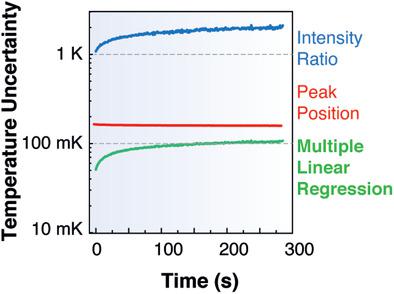当前位置:
X-MOL 学术
›
Laser Photonics Rev.
›
论文详情
Our official English website, www.x-mol.net, welcomes your
feedback! (Note: you will need to create a separate account there.)
Going Above and Beyond: A Tenfold Gain in the Performance of Luminescence Thermometers Joining Multiparametric Sensing and Multiple Regression
Laser & Photonics Reviews ( IF 9.8 ) Pub Date : 2021-08-21 , DOI: 10.1002/lpor.202100301 Fernando E. Maturi 1, 2 , Carlos D. S. Brites 1 , Erving C. Ximendes 3 , Carolyn Mills 4 , Bradley Olsen 4 , Daniel Jaque 3 , Sidney J. L. Ribeiro 2 , Luís D. Carlos 1
Laser & Photonics Reviews ( IF 9.8 ) Pub Date : 2021-08-21 , DOI: 10.1002/lpor.202100301 Fernando E. Maturi 1, 2 , Carlos D. S. Brites 1 , Erving C. Ximendes 3 , Carolyn Mills 4 , Bradley Olsen 4 , Daniel Jaque 3 , Sidney J. L. Ribeiro 2 , Luís D. Carlos 1
Affiliation

|
Luminescence thermometry has substantially progressed in the last decade, rapidly approaching the performance of concurrent technologies. Performance is usually assessed through the relative thermal sensitivity, Sr, and temperature uncertainty, δT. Until now, the state-of-the-art values at ambient conditions do not exceed maximum Sr of 12.5% K−1 and minimum δT of 0.1 K. Although these numbers are satisfactory for most applications, they are insufficient for fields that require lower thermal uncertainties, such as biomedicine. This has motivated the development of materials with an improved thermal response, many of them responding to the temperature through distinct photophysical properties. This paper demonstrates how the performance of multiparametric luminescent thermometers can be further improved by simply applying new analysis routes. The synergy between multiparametric readouts and multiple linear regression makes possible a tenfold improvement in Sr and δT, reaching a world record of 50% K−1 and 0.05 K, respectively. This is achieved without requiring the development of new materials or upgrading the detection system as illustrated by using the green fluorescent protein and Ag2S nanoparticles. These results open a new era in biomedicine thanks to the development of new diagnosis tools based on the detection of super-small temperature fluctuations in living specimens.
中文翻译:

超越极限:结合多参数传感和多重回归的发光温度计性能提高十倍
发光测温在过去十年中取得了重大进展,迅速接近并发技术的性能。性能通常通过相对热灵敏度S r和温度不确定性 δ T来评估。到目前为止,环境条件下的最新值不超过12.5% K -1 的最大S r和最小 δ T0.1 K。虽然这些数字对于大多数应用来说是令人满意的,但对于需要较低热不确定性的领域(例如生物医学)来说,它们是不够的。这推动了具有改进热响应的材料的开发,其中许多材料通过不同的光物理特性响应温度。本文展示了如何通过简单地应用新的分析路线来进一步提高多参数发光温度计的性能。多参数读数和多元线性回归之间的协同作用使S r和 δ T提高十倍成为可能,达到 50% K -1的世界纪录和 0.05 K,分别。这是在不需要开发新材料或升级检测系统的情况下实现的,如使用绿色荧光蛋白和 Ag 2 S 纳米颗粒所示。由于开发了基于检测活体标本超小温度波动的新诊断工具,这些结果开启了生物医学的新时代。
更新日期:2021-08-21
中文翻译:

超越极限:结合多参数传感和多重回归的发光温度计性能提高十倍
发光测温在过去十年中取得了重大进展,迅速接近并发技术的性能。性能通常通过相对热灵敏度S r和温度不确定性 δ T来评估。到目前为止,环境条件下的最新值不超过12.5% K -1 的最大S r和最小 δ T0.1 K。虽然这些数字对于大多数应用来说是令人满意的,但对于需要较低热不确定性的领域(例如生物医学)来说,它们是不够的。这推动了具有改进热响应的材料的开发,其中许多材料通过不同的光物理特性响应温度。本文展示了如何通过简单地应用新的分析路线来进一步提高多参数发光温度计的性能。多参数读数和多元线性回归之间的协同作用使S r和 δ T提高十倍成为可能,达到 50% K -1的世界纪录和 0.05 K,分别。这是在不需要开发新材料或升级检测系统的情况下实现的,如使用绿色荧光蛋白和 Ag 2 S 纳米颗粒所示。由于开发了基于检测活体标本超小温度波动的新诊断工具,这些结果开启了生物医学的新时代。











































 京公网安备 11010802027423号
京公网安备 11010802027423号